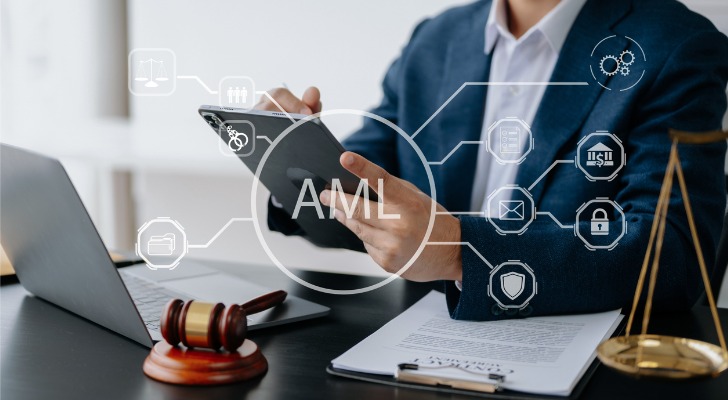Navigating the complex maze of financial regulations may seem daunting as a financial advisor, yet it remains a crucial responsibility of your profession. Take, for instance, Anti-Money Laundering (AML) Compliance – a set of rules that, when misunderstood or overlooked, can lead to detrimental consequences. These are good regulations that help protect client money and help them feel comfortable investing with you or another advisor. AML compliance contains rules you need to follow to make sure all client assets are protected.
SmartAsset’s Advisor Marketing Platform offers financial advisors services like client lead generation, automated marketing and more. Learn about SmartAsset AMP today.
What Is Anti-Money Laundering (AML) Compliance
The importance of AML compliance, underscored by regulations like the Bank Secrecy Act and the USA PATRIOT Act, and the repercussions of non-compliance, cannot be overstated. AML Compliance constitutes crucial laws, guidelines and procedures designed to prohibit the concealment of illicitly sourced funds as legitimate earnings. Financial advisors are on the frontlines, expected to understand and implement these measures as part of their professional commitments.
Real-life scandals like those involving 1MDB in Malaysia, Danske Bank in Europe or Deutsche Bank’s AML lapses, paint a stark picture of why these practices are essential. These instances don’t just result in substantial financial losses but tarnish the reputation of the financial sector and erode client trust.

Client Acquisition Simplified: For RIAs
- Ideal for RIAs looking to scale.
- Validated referrals to help build your pipeline efficiently.
- Save time + optimize your close rate with high-touch, pre-built campaigns.

CFP®, CEO
Joe Anderson
Pure Financial Advisors
We have seen a remarkable return on investment and comparatively low client acquisition costs even as we’ve multiplied our spend over the years.
Pure Financial Advisors reports $1B in new AUM from SmartAsset investor referrals.
What to Know About AML for Your Advisory Firm
AML compliance for advisory firms entails various requirements, like thorough due diligence, implementing a customer identification program, reporting suspicious actions and maintaining a robust AML compliance program. Each element works towards preventing the unwitting facilitation of money laundering activities.
Understanding these requirements is crucial, given the repercussions of non-compliance. For instance, look deeper into the Deutsche Bank example, where a $186 million fine was imposed due to AML shortcomings. It’s not just about the monumental fine, but also the reputational damage that could potentially trigger a loss of business.
Creating an AML Compliance Program
Setting up an effective AML compliance program could seem like an uphill task, but it’s a necessity that could fortify your practice. Start by appointing a compliance officer well-versed in AML procedures tasked with pinpointing potential compliance pitfalls. This isn’t something you should try to do without some expertise in the matter.
Developing and implementing internal policies and strategies for AML compliance is also pivotal. These could cover how your firm conducts due diligence or reports suspicious activities. Detailed, practical examples could include a customized reporting format or a unique procedure for verifying customer identification.
Regularly training employees on AML regulations, as well as the firm’s policies, and conducting independent audits to gauge the effectiveness of the AML compliance program, are also essential steps to make sure you continue to stay compliant as you manage client assets.
Technology That Can Help With AML Compliance

In the struggle to maintain compliance, technology could be a game-changing ally. Systems like Oracle Financial Services Anti Money Laundering, SAS Anti-Money Laundering and Thomson Reuters World-Check can automate compliance processes.
Any designed system like this can help by reducing the risk of manual errors and speedily identifying suspicious activities. Each of these tools provides unique benefits – Oracle Financial, for example, uses machine learning for advanced analytics, whereas SAS uses network analytics for better risk detection.
However, remember that while technology can ease the journey toward AML compliance, it doesn’t replace the human expertise and precision that a dedicated financial advisor can provide.
Tips for Staying AML Compliant as a Financial Advisor
Staying Anti-Money Laundering (AML) compliant as a financial advisor is crucial to ensure that your business operates within the law and maintains its integrity. AML regulations are designed to prevent money laundering and the financing of illegal activities. Here are 10 common tips to help you stay AML-compliant:
- Know your customer (KYC) procedures: Implement robust KYC procedures to verify the identity of your clients. Collect and retain relevant documentation, such as government-issued IDs, proof of address, and financial statements.
- Risk assessment: Conduct risk assessments to categorize clients based on their risk profile. Assign higher scrutiny to clients with higher risk factors, such as politically exposed persons (PEPs) or those engaged in high-risk activities.
- AML training: Provide comprehensive AML training to your staff to ensure they understand the regulations and their role in compliance. Regularly update training to reflect changes in AML laws and regulations.
- Transaction monitoring: Implement automated systems for transaction monitoring to detect suspicious activities. Establish thresholds for transaction monitoring and report any unusual or suspicious transactions to relevant authorities.
- Suspicious activity reporting: Develop clear procedures for reporting suspicious activities to the appropriate authorities. Maintain records of all reports and actions taken.
- Customer due diligence (CDD): Perform enhanced due diligence on high-risk clients and monitor client transactions and account activity for inconsistencies.
- Record keeping: Maintain comprehensive records of client transactions, communications, and due diligence efforts. Keep records for the prescribed period as mandated by AML regulations.
- AML compliance officer: Appoint an AML compliance officer responsible for overseeing AML procedures, reporting and training within your organization.
- Regular audits and reviews: Conduct regular internal audits and reviews of your AML policies and procedures to ensure they remain effective and up-to-date.
- Stay informed: Stay informed about changes in AML laws and regulations, both at the national and international levels.
Remember that AML compliance is an ongoing process that requires vigilance and adaptability. It’s essential to stay proactive and regularly update your AML policies and procedures to meet the evolving regulatory landscape. Consulting legal experts or compliance professionals can also be beneficial in ensuring you meet all relevant requirements.
Bottom Line

The road might seem arduous, but with diligence and commitment, financial advisors can effectively lead their firms toward AML compliance, thus shielding the respectability of the financial sector. With the right knowledge, process-oriented thinking, prudent use of technology, and potentially the help of an experienced financial advisor, advisory firms can fortify their stands against money laundering, embodying the core values of integrity and trust in the financial sector.
Tips for Building Your Advisor Practice
- SmartAsset AMP (Advisor Marketing Platform) is a holistic marketing service financial advisors can use for client lead generation and automated marketing. Sign up for a free demo to explore how SmartAsset AMP can help you expand your practice’s marketing operation. Get started today.
- If you’re looking for more tips to grow your advisor practice, SmartAsset’s collective advisory practice content helps you do just that.
Photo credit: ©iStock.com/Wipada Wipawin, ©iStock.com/Thicha Satapitanon, ©iStock.com/nuttapong punna